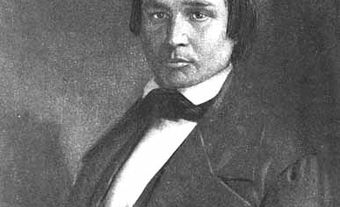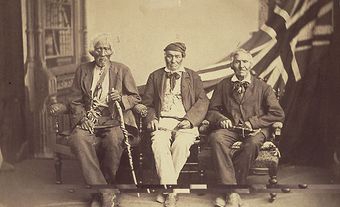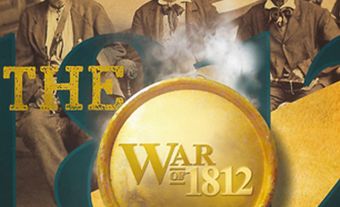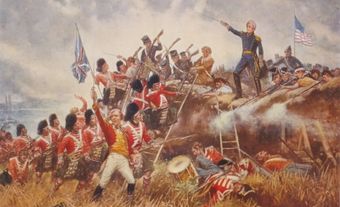Tecumseh, Shawnee chief, leader of a First Nations confederacy, military leader in the War of 1812 (born circa 1768 in south-central Ohio; died 5 October 1813 near Moraviantown [Thamesville, ON]). Tecumseh was leader of the First Nations confederacy that was formed to resist American intrusion on Indigenous land in the late 18th and early 19th centuries. When the War of 1812 broke out between the United States and Britain, Tecumseh and the confederacy allied with the British. He was killed at the Battle of the Thames in 1813. Tecumseh is remembered as a respected Indigenous warrior and major figure in the War of 1812. While his death was the end of serious resistance in the Northwest, Indigenous people continued to fight for their land and rights.
Tecumseh's Childhood
Tecumseh's parents were Shawnee who lived among the Creek in what is now Alabama and Georgia. The Shawnee had been dislodged from Ohio in the late 17th century by the Haudenosaunee. In 1759 Tecumseh's parents moved north as part of an attempt to reunite the tribe on the Ohio River. The Shawnee believed that they were the Great Spirit's special people, that he had given them a portion of his heart. Tecumseh's father Pukeshinwau was a Shawnee chief.
Tecumseh was likely born on the Scioto River at either Chillicothe or Kispoko, in around 1768. His name is generally understood to mean Shooting Star and is associated with a celestial panther, the spiritual patron of the family's Kispoko clan. During Tecumseh's childhood, the Shawnee lived through and fought many wars. Five times from 1774 to 1782, invading armies occupied Shawnee territory. In the Treaty of Fort Stanwix, 1768, the Haudenosaunee, who claimed to have conquered the Ohio country, sold the land to the Americans. Surveyors and American militia were a constant sight. With a population of only 1,000, the Shawnee had little hope of resisting the onslaught of land-hungry settlers and the United States military. Pukeshinwau, Tecumseh’s father, was killed in one of the confrontations on 10 October 1774 at Point Pleasant.
In 1777, the Shawnee split, with some relocating to valleys of the Little and Great Miami Rivers. Tecumseh moved to Pekowi on the Mad River, a tributary of the Great Miami. From his childhood Tecumseh naturally regarded the Americans, the "Long Knives,"as his enemies. They had seized Shawnee land, killed his father and destroyed his towns. Tecumseh's Kispoko clan lacked the standing of the other clans but had a reputation for fighting second to none among First Nations.
Pan-Indian Movement 1783–95
After the 1783 Treaty of Paris (following the American Revolution), Congress moved speedily to annex land north of the Ohio. Organizing First Nations resistance was difficult. The nations were deeply divided by language and outlook. There had been several attempts to form alliances. The ambitious pan-Indian movement of 1783–95 began at Lower Sandusky and was led by Kanyen'kehà:ka (Mohawk) chief Joseph Brant. From this movement came the idea that the land belonged to all Indigenous people and that negotiations with individual nations were invalid. But groups succumbed one by one.
In 1785 the Shawnee were summoned to meet on the Great Miami at Fort Finney and were intimidated into signing a treaty surrendering their homeland. The negotiators were reprimanded by the rest of the nation. In the battles that followed, Tecumseh saw his first action as a warrior. He first proved himself in an attack on a flatboat on the Ohio River in 1788. (See also Treaties with Indigenous Peoples in Canada.)
Tecumseh soon gained a reputation as a bold warrior. Nevertheless, he missed participating in the single greatest victory by Indigenous people against the armed forces of the United States: on 4 November 1791 on the banks of the Wabash River, Major General Arthur St. Clair with a force of 1,500 regulars and 800 militia was routed by 2,000 warriors led by Blue Jacket and the Miami under chief Little Turtle.
At Buchanan Station, south of Nashville, Tecumseh's highly regarded brother Cheeseekau was killed in an attack on a small fortification. Tecumseh subsequently fought a number of skirmishes with the Long Knives, proving himself a worthy successor to his brother.
The confederacy's dream of independence was shattered in 1794 when a well-trained American army under Major General Anthony Wayne defeated a number of First Nations attacks. At the Battle of Fallen Timbers (20 August 1794) the Americans attacked with 3,500 men; though outnumbered, the First Nations fought tenaciously. Tecumseh distinguished himself when he charged a group of Americans who had a field piece, cutting loose the horses, and riding off. The Treaty of Greenville ended this phase of the conflict; though Tecumseh did not approve of the treaty, he was still only a minor chief.
Tecumseh led a band of 250, including some 40–50 warriors, and created an independent village on Buck Creek. With the inexorable advance of the Americans and the destruction of the hunting grounds the band moved again in the spring of 1798 to the west fork of the White River (Indiana). At the turn of the century, there were fears for their livelihood, for land, for culture and, most terrifying, for their survival in the face of epidemic diseases to which the people had no immunity.
The Prophet
It was at this time that Tecumseh's brother Lalawéthica stepped forward. In 1805 Lalawéthica had a frightening dream that transformed him overnight. He began to preach with great emotion and became known as the Prophet. He spoke against the evils of alcohol, dishonesty, slander and particularly against loss of the old traditions. He predicted that divine intervention would deliver the people if they would purge themselves of white influence.
All through 1806 and 1807 people came to hear the Prophet, who preached racial separation and animosity to Americans, "who grew from the Scum of the great Water when it was troubled by the Evil Spirit." Tecumseh's pan-tribalism was less religious and firmly based on his belief that "the Great Spirit intended it [the land] as the common property of all the tribes, nor can it be sold without the consent of all." In this light all the recent treaties were considered invalid.
Spectre of War
On 22 June 1807 a distant event cast a shadow on Tecumseh's attempts to protect his land. The Chesapeake Affair raised the spectre of war between the United States and Britain. The British in Canada still traded with First Nations south of the Great Lakes, and distributed presents to them. The redcoats wanted to secure favour among the First Nations but did not want to be seen by the Americans as inciting them. These relations aroused deep suspicion in the United States. American officials "eagerly embraced a convenient paranoia," as Tecumseh's biographer John Sugden put it.
With the threat of war, Tecumseh moved his band to the headwaters of the Mississinewa, five kilometres from Tippecanoe. The move was resented by the local Miami and Delaware peoples. The impressive new Shawnee village, with 200 houses, was called Prophetstown by the white settlers for Tecumseh's brother, who continued preaching and who changed his name to Tenskwatawa, meaning Open Door.
Tecumseh's First Visit to Canada
In 1808 an unknown Tecumseh made his first visit to Canada at Fort Amherstburg (later Fort Malden), Upper Canada, in the place of his better-known brother who had been invited by William Claus. He arrived 8 June. Tecumseh was not enthusiastic to take the king by the hand. He was deeply distrustful of the British. Nevertheless, the two sides met and Tecumseh established himself with the redcoats and raised his standing among the First Nations. In spring 1809 Tecumseh made the first of his journeys in the cause of Indigenous unity, among the Seneca and Wyandot peoples in Ohio and the Six Nations in New York. He had developed into a fiery orator with a clear message: the First Nations must stand together to save their land and cultures.
While Tecumseh was absent, Governor William Henry Harrison of Indiana Territory established the Treaty of Fort Wayne — a huge land grab. This treaty vindicated Tecumseh and roused him to a fury. When he returned to talk to the British at Fort Amherstburg in 1810, he had changed his attitude. He was ready for war and to throw in his lot with the British.
Attack on the Confederacy
Tecumseh's task of building an Indigenous confederacy was enormous given the forbidding geographical distances, the sense of powerlessness of many of the First Nations, the jealousy of the older chiefs, tribal rivalries, and communication in different languages. Even the different Algonquian groups could not understand one another without interpreters.
In summer 1810 Tecumseh undertook a strenuous journey west to the upper Mississippi, down the Illinois River to Peoria, to present-day Wisconsin, then to Missouri. In October he set out for Fort Amherstburg, arriving about 12 November. By now he was certain there would be war and asked for supplies. Tecumseh's efforts did not go unnoticed. William Henry Harrison wrote a tribute in 1811: "The implicit obedience and respect which the followers of Tecumseh pay to him is really astonishing, and more than any other circumstance bespeaks him one of those uncommon geniuses which spring up occasionally to produce revolutions and overturn the established order of things."
Harrison met Tecumseh at Vincennes in July 1811. Tecumseh erred by telling Harrison that he would be absent until spring. In Tecumseh's absence, Harrison moved a force near Prophetstown at the confluence of the Tippecanoe and Wabash Rivers. The Prophet was unable to restrain his warriors and sniping between sentries escalated into a full-scale battle. The warriors held their own but were forced to withdraw when they ran out of ammunition. Harrison followed the retreat and entered Prophetstown, finding it deserted. His men burned the town and destroyed the food supplies.

Tecumseh's absence took him some 5,000 km and when he returned to Prophetstown he saw the grim reality of the destruction: as he told the British later, "the bodies of my friends laying in the dust, and our villages burnt to the ground, and all our kettles carried off." Tecumseh was furious with his brother for falling for Harrison's trap and threatened to kill him. It was a devastating blow to the confederacy.
Outbreak of the War of 1812
On 18 June 1812 the United States declared war on Britain. Tecumseh went north to find the British strengthening the defences of Fort Amherstburg and saw an impressive number of soldiers there. Tecumseh brought about 350 warriors from numerous nations. General William Hull's American forces occupied Sandwich on 12 July, but the general was fraught with doubt. On 17 July, far to the north, Captain Charles Roberts forced the surrender of Michilimackinac, which further unnerved Hull.
On 25 July, American Major James Denny marched 120 Ohio volunteers in sight of Tecumseh's camp. Tecumseh organized an ambush, routing them and inflicting the first casualties suffered by Americans in the War of 1812. On 2 and 3 August, Tecumseh, Roundhead and Captain Adam Muir brought a force of Indigenous warriors and redcoats across the Detroit River and attacked the American supply road below Brownstown. On 5 August, Tecumseh confronted a far more numerous force south of Brownstown, killing 18. In another attack he surprised Van Horne, killing 20 and wounding 12. The ambushes at Brownstown were remarkable victories and weighed heavily on Hull's fragile frame of mind.
On 9 August 1812, soldier and future writer John Richardson met Tecumseh, whom he was the first to call the real hero of the war. He described "that ardour of expression in his eye... that could not fail to endear him to the soldier hearts of those who stood around him." This was at Maguaga where again the allies were outnumbered by the Americans sent out to protect another supply train heading for Detroit. But Tecumseh chose the ground well and signalled the attack. Outgunned, the First Nations and British were forced to retreat and Tecumseh was wounded in the neck. It was an American victory but, as happened so often in this war, there was no follow-up and the blockade of Detroit remained intact. These incursions against his supply lines continued to disturb General Hull.
Brock and the Capture of Detroit
On 13 August 1812 General Isaac Brock arrived at Amherstburg and the famous meeting took place between him and the Shawnee chief. Brock's aide, Captain John Glegg, described Tecumseh "with bright eyes beaming cheerfulness, energy and decision." Brock's bold decision to attack Detroit was opposed by all his advisors but deeply impressed Tecumseh, who was said to declare of Brock,"This is a man!"
On the night of 15 August, hundreds of canoes glided across the river to land near Detroit, led by Tecumseh, Roundhead and others. The British followed at daylight on the 16th, south of the town. Brock marched directly on the town while Tecumseh's men swept north through the forest. Hull had no idea how many First Nations warriors were present, but he feared thousands. British ships shelled the fort with more psychological impact than real. Unbelievably, Hull surrendered without a shot.
Hull's ignominious surrender certainly caused him and his nation grief. Unquestionably Tecumseh's harassment of his supply lines and his fear of a savage massacre at the hands of the First Nations (learned from his captured letters) played a big part in his decision. It was a great victory for the allies, seen by many as the saving of Upper Canada, and a demoralizing defeat for the Americans. Tecumseh played a major role and gained the admiration of Brock, who called him the "Wellington of the Indians." In a letter to Prime Minister Lord Liverpool, Brock wrote: "A more sagacious or more gallant warrior does not, I believe, exist."
It needs to be made clear, however, in this process of making Tecumseh into a Canadian hero, that he himself did not care, as one historian has put it, "a spent pistol ball" for the king or the colony of Upper Canada. Tecumseh's obsession was the plight of his people and his own ambition to unite all the First Nations.
Campaigns in the Northwest
After some failures of the allies on the Maumee and at Forts Wayne, Madison and Harrison, there was a stalemate in the mid-West. Tecumseh decided that his priority was to recruit as many warriors as he could for the defence of Canada. After a serious illness, Tecumseh returned to the Detroit area for an attack on Fort Meigs. The Americans had greatly strengthened the fort with 1,200 men, well-engineered defences and powerful armament. The British began a bombardment on 30 April but Tecumseh had serious doubts about attacking the fort, which deepened with the arrival of 1,400 reinforcements from Kentucky. While the allies were preoccupied, Colonel John Miller slipped from the fort and surprised the British guns. Tecumseh realized what was happening and vigorously counterattacked and recovered the guns. The siege was lifted 5 May.
The British loss of the Battle of Lake Erie (Put-in-Bay) on 10 September was a serious blow to Tecumseh and the British in western Upper Canada. General Procter decided, without telling Tecumseh, that his position at Amherstburg was untenable with his supply lines threatened and that he would have to withdraw. Tecumseh was outraged and castigated Procter by likening him to "a fat animal that carries its tail upon its back; but when affrighted, it drops it between its legs and runs off." Procter's plan to withdraw along the lower Thames was sound but his implementation was extremely incompetent. He dithered about where to make a stand, changing his mind three times, and when he chose the spot on the north bank of the Thames, 1.6 km from Moraviantown, his men were confused, dispirited and hungry.
Tecumseh's Death
Prior to the Battle of the Thames (Moraviantown), William Caldwell sat with Tecumseh and the chief suddenly started as if shot. Tecumseh said that he "could not exactly tell, but it was an evil spirit which betokens no good." Procter lined up his men in the open with Tecumseh's warriors in a thick wood to the right. The redcoat line was broken in an instant. With 43 dead, the rest surrendered. Procter fled in a shameful display. When the Americans picked their way through the swamp to charge the First Nations Tecumseh had no intention of retreating without a fight, despite being outnumbered 3,000 to 500. His warriors rose from cover and delivered a volley. Tecumseh stood reassuringly tall, firing his musket and yelling encouragement. He sprinted forward at one of the Americans, who raised his gun and fired.

The British lost 634 men killed or captured in the battle, but the greatest loss was Tecumseh. His body was discovered on the field, identified by Anthony Shane. Observers noted that his body bore numerous injuries. American soldiers had scalped the body and torn strips of skin to make razor strops. Harrison and Shane admitted to being mortified by the abuse. No one knows where the body was buried. Some stories tell of his warriors spiriting it away to an unmarked grave.
Tecumseh's death was the end of serious resistance in the Northwest. Odawa Chief Naywash said it clearly: "Since our Great Chief Tecumtha [sic] has been killed we do not listen to one another, we do not rise together." Procter was disgraced and court martialled.
When peace came at Ghent it did nothing for the First Nations; the redcoats had failed them again.
Tecumseh's Legacy
Was it necessary for Tecumseh to die prematurely at Moraviantown for him to be made into a hero? It seems unlikely for there were battles to be fought and the First Nations continued to fight. He was perhaps the major figure of all three sides in the war and little has been said of his impressive effect that was not said at the time. That is not to say that his life, character and accomplishment — and ultimate failure — have not been fictionalized, exaggerated or worse. But no reflection of his life can fail to evoke its tragedy and the calamity that befell his people.

 Share on Facebook
Share on Facebook Share on X
Share on X Share by Email
Share by Email Share on Google Classroom
Share on Google Classroom









